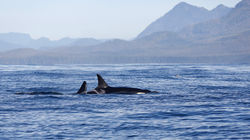Encounter #108 - Oct 15, 2024
 L127Copyright © 2024 Center for Whale Research |  L127 and L121Copyright © 2024 Center for Whale Research |  K42Copyright © 2024 Center for Whale Research |
|---|---|---|
 K35 and K16Copyright © 2024 Center for Whale Research |  K45Copyright © 2024 Center for Whale Research |  K33Copyright © 2024 Center for Whale Research |
 L121Copyright © 2024 Center for Whale Research |  K38 and L122Copyright © 2024 Center for Whale Research |  K12Copyright © 2024 Center for Whale Research |
 K14Copyright © 2024 Center for Whale Research |  K37Copyright © 2024 Center for Whale Research |  L118Copyright © 2024 Center for Whale Research |
 L115 and L119Copyright © 2024 Center for Whale Research |  L105Copyright © 2024 Center for Whale Research |  L91, K43, and L103Copyright © 2024 Center for Whale Research |
 L106Copyright © 2024 Center for Whale Research |  L88Copyright © 2024 Center for Whale Research |  L87Copyright © 2024 Center for Whale Research |
 L86Copyright © 2024 Center for Whale Research |  L82Copyright © 2024 Center for Whale Research |  L72 and L105Copyright © 2024 Center for Whale Research |
 L55Copyright © 2024 Center for Whale Research |  K45Copyright © 2024 Center for Whale Research |  L54Copyright © 2024 Center for Whale Research |
 K43 and L103Copyright © 2024 Center for Whale Research |  K43Copyright © 2024 Center for Whale Research |  K43Copyright © 2024 Center for Whale Research |
 K42Copyright © 2024 Center for Whale Research |  K42Copyright © 2024 Center for Whale Research |  K38Copyright © 2024 Center for Whale Research |
 K37Copyright © 2024 Center for Whale Research |  K37Copyright © 2024 Center for Whale Research |  K35 and K16Copyright © 2024 Center for Whale Research |
 K33, L22, and L113Copyright © 2024 Center for Whale Research |  K35Copyright © 2024 Center for Whale Research |  K27 and L82Copyright © 2024 Center for Whale Research |
 K22Copyright © 2024 Center for Whale Research |  K14Copyright © 2024 Center for Whale Research |  K20Copyright © 2024 Center for Whale Research |
 K12Copyright © 2024 Center for Whale Research |  L121 and L127Copyright © 2024 Center for Whale Research |  L121Copyright © 2024 Center for Whale Research |

Your financial support makes our work possible
Please DONATE
EncDate:15/10/24
EncSeq:1
Enc#:108
ObservBegin:11:55 AM
ObservEnd:02:10 PM
Vessel:Mike 1
Staff:Mark Malleson
Other Observers:Joe Zelwietro
Pods:K, L
LocationDescr:Swiftsure Bank
Start Latitude:48 31.66
Start Longitude:124 50.02
End Latitude:48 30.05
End Longitude:124 51.81
EncSummary:
Mark and Joe departed Victoria with First Mutt Fin at 0800 for an October survey of the Juan de Fuca Strait. They passed several humpback whales feeding around Race Rocks, bulking up for their approaching trip home to the tropics, but the next 25 miles were comparatively quiet, as they did not observe any cetaceans between Becher Bay and Sombrio Point. They began spotting more humpbacks just west of Sombrio, but it wasn’t until they reached the west entrance to the Strait that they finally spotted the first tall black dorsal fins of the day. The team had hoped to find Southern Resident killer whales after spending the prior weekend observing them (see Encounters #99, #100). Sure enough, the first animal they photographed was indeed L22! She was foraging near several others, including K22 and her mature son K33, and L83. L83 was observed here a little over a week ago, perhaps babysitting L128 as the youngest whale’s mother foraged nearby. No calf was observed today. L83 shortly joined her son L110 and the two moved off to forage together. The L86s were the next animals observed, foraging alongside two young members of the L12 matriline, L121 and L127. L105 and L72 appeared from the northwest, and led Mark and Joe to more of K pod.
They documented all three of the K20s, foraging alongside L122, before moving off to the southwest and a denser group of animals. L87, L116 and L123 were catching up to a tight group of seven females, including K27, K36, K43, and several of the L55s. The team watched for several minutes as this group charged west, then paused to socialize or prey-share, before beginning to disperse.
After a brief interlude, wondering where to move next, another wave of mixed Ks and Ls appeared to the northeast. These animals included the balance of the L55s – L55 and L109 – with several K14s and K16s. this group was pushing southwest toward the others, and the CWR team paced them until L25 popped up in their path, foraging on her own. She led the guys to the first sighting of the L54s for the day, as the matriarch herself travelled south alongside her sons, L108 and L117. L88 soon appeared to the west, completing the quartet – L88 has travelled consistently with L54 and her offspring for several years, and is generally included in “the L54s”. The CWR crew ended the encounter with the L54s trending southwest with the rest of the clan, less J pod, and began the near-65 nautical mile journey back to Victoria.
Mark and Joe were pleased to document all of the L47s this day, after seeing none of them a week ago, but were unable to find L90 amongst the crowd. K26 was the only K pod individual not photographed, but he too could have easily escaped detection in the large swells and widely spread whales.
Photos taken under Federal Permits
NMFS PERMIT: 27038/DFO SARA 388
